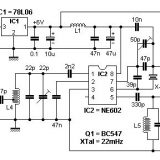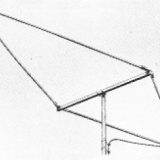W3LPL Beverage Antenna Construction
 I (W3LPL) use separate phased Beverage arrays on 160M, 80M and 40M.
I (W3LPL) use separate phased Beverage arrays on 160M, 80M and 40M.
If u plan to use a simple beverage ant, as opposed to phased beverages, u can certainly use a 580′ ant on both 80 & 160. A 580′ beverage works very well on 80 but is not long enough to work particularly well on 160.
Factors to keep in mind when selecting Beverage ant length:
As W1WCR points out, in his “Beverage Antenna Handbook”, certain lengths produce a very desirable “cone of silence” off the back of the antenna.
The preferred “cone of silence” lengths are:
| 1 Half Wave Length Wire * | One Wave Length Wire * | 1 & 1/2 Wave Length Wire * | Two Wave Length Wire * | |
| 3 dB beamwidth | 180 deg | 110 deg | 80 deg | 50 deg |
| RX Angle | 65 deg | 48 deg | 41 deg | 35 deg |
| F/B Ratio | 24 db | 22 db | 20 db | 18 db |
| 160M | 290 Feet | 585 Feet | 880 Feet | 1160 Feet |
| 80M | 150 Feet | 295 Feet | 440 Feet | 580 Feet |
| 40M | 75 Feet | 150 Feet | 225 Feet | 295 Feet |
* Lengths given are a little longer than the actual .5, 1, 1.5 & 2 wavelength (formula) distances but they’re close enuf to be referred to as .5, 1, 1.5, & 2 wavelength designations.
Longer beverage antennas produce POORER front to back ratios! Beyond the 1/2 wave length shown above, (as u can see) 4db of F/B is lost each time the wire length doubles. As a result, if F/B is your prime consideration then the .5 & 1 wavelength would be preferred.
Short beverage antennas have a very broad main lobe, poorer response to low angle signals & lower sensitivity. Of the 4 lengths given above, the shortest length (.5 wave) has a 3 db beamwidth of almost 180 degrees, not very desirable! (unless its the best u can do)
The 1 wavelength version has a 110 deg beamwidth (better, but still not good) 1.5 wavelegenth bev has a 80 deg beamwidth while the 2 wavelength model offers a very desirable 50 deg beamwidth, but only 17-18 db Front to Back.
Conclusions/Observations of above material, Re single wire beverages. (KG4W’s words)
– First of all, any Beverage that you can install regardless of its length (200 foot min) is going to help your reception on the low bands at times.
– The .5 wavelength bev offers more front/back ratio but a much broader pattern & higher angle of receive than does the 2 wavelength version, conversly a 2 wavelength bev has less front/back but a much more narrow pattern & a lower angle of receive.
– Put up “what you can” if u have the time/space/desire to optimize seperate beverages for different bands then use the above data to do so.
– If your bev must function for you on all bands (ie 40 80 160) as is usually the case, then I think the 1 or 1.5 wavelength versions above will provide the best overall performance. Again, I cant over emphasize, “whatever u put up that is 200′ or longer is going to provide improved low band reception”
W3LPL’ words cont. The advantage of phased (half wavelength spaced) pairs of Beverages is that you get the front-to-back ratio advantage of short Beverages, the narrow beamwidth & sensitivity of long Beverages, & the fantastic front-to-side ratio resulting from the phased pairs that is unavailable with any single Beverage antenna length!
Phased Beverages W3LPL’s recommendations:
160M I suggest phased 585 or 880 foot Beverages spaced 270 ft apart.
80M the preferred phased Beverage lengths are 295 or 440 feet, spaced 135 ft apart.
40M the preferred phased Beverage lengths are 150 ft or 225 ft spaced 70 ft apart.
N2RM’s compromise of two 580 foot Beverages spaced 200 feet is a proven performer on both 80 and 160.
Below is a schematic of N2RM’s duo-band system as KG4W sees it. The concept is applicable to LPL’s monoband systems also.

The use of the 2 impedence values (50 & 75 ohm coax) is not mandentory. It would just offer a better match at the “T” ie- 50 ohm to 37.5 as opposed 75 to 37.5 ohms if all 75 ohm is used and 50 to 25 if all 50 ohm were used. Then again, if we dont use matching transformers where the coax joins the bev wire then we have a more serious miss-match ie- 50 or 75 ohms looking at the 450 ohms of the antenna. But (you know what) without regard to any impedence matching they still work better than most anything u gonna have on the low bands.


















Great information! Thank you. I will be installing my first beverage next week and this information has been great reference for me.